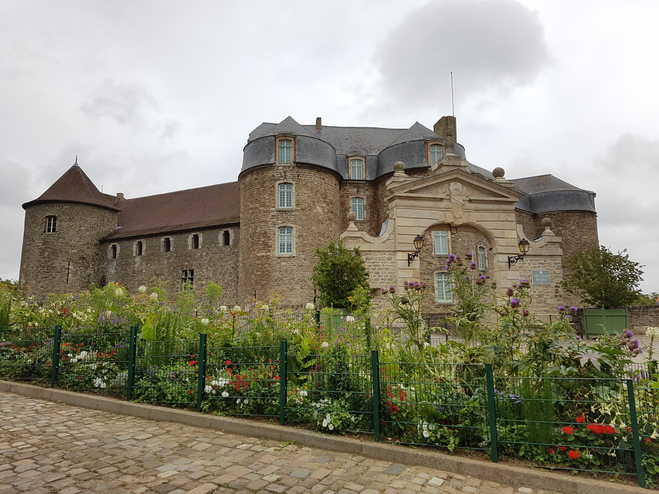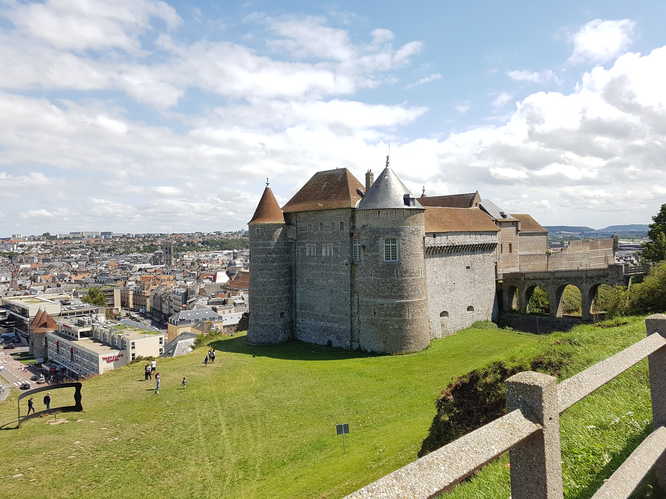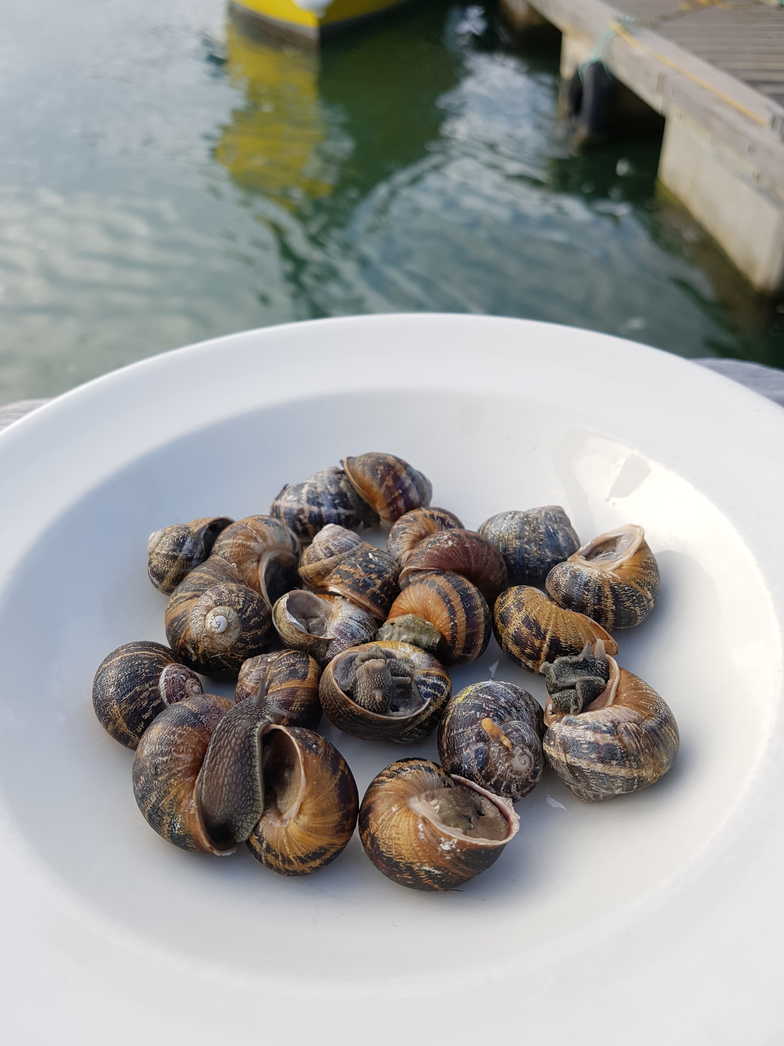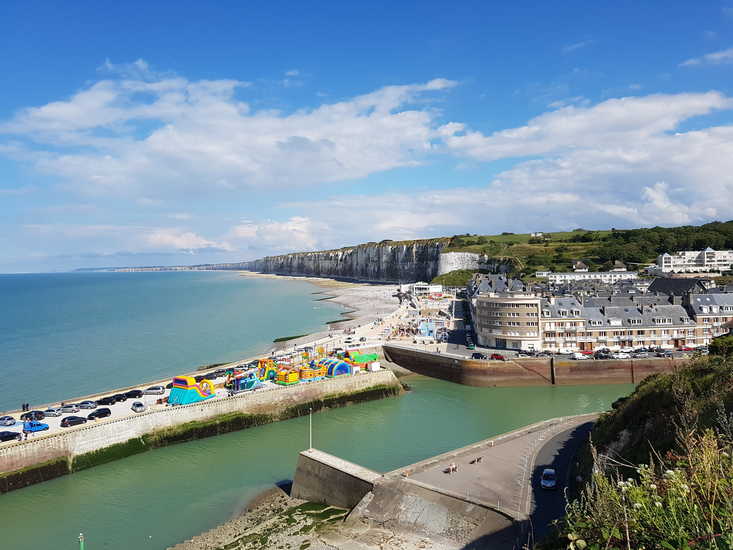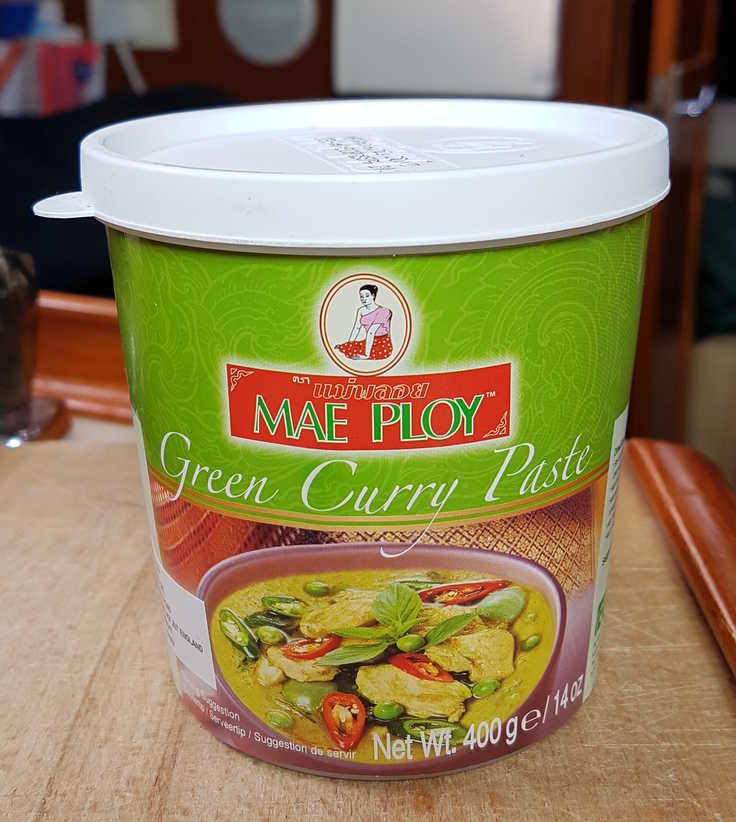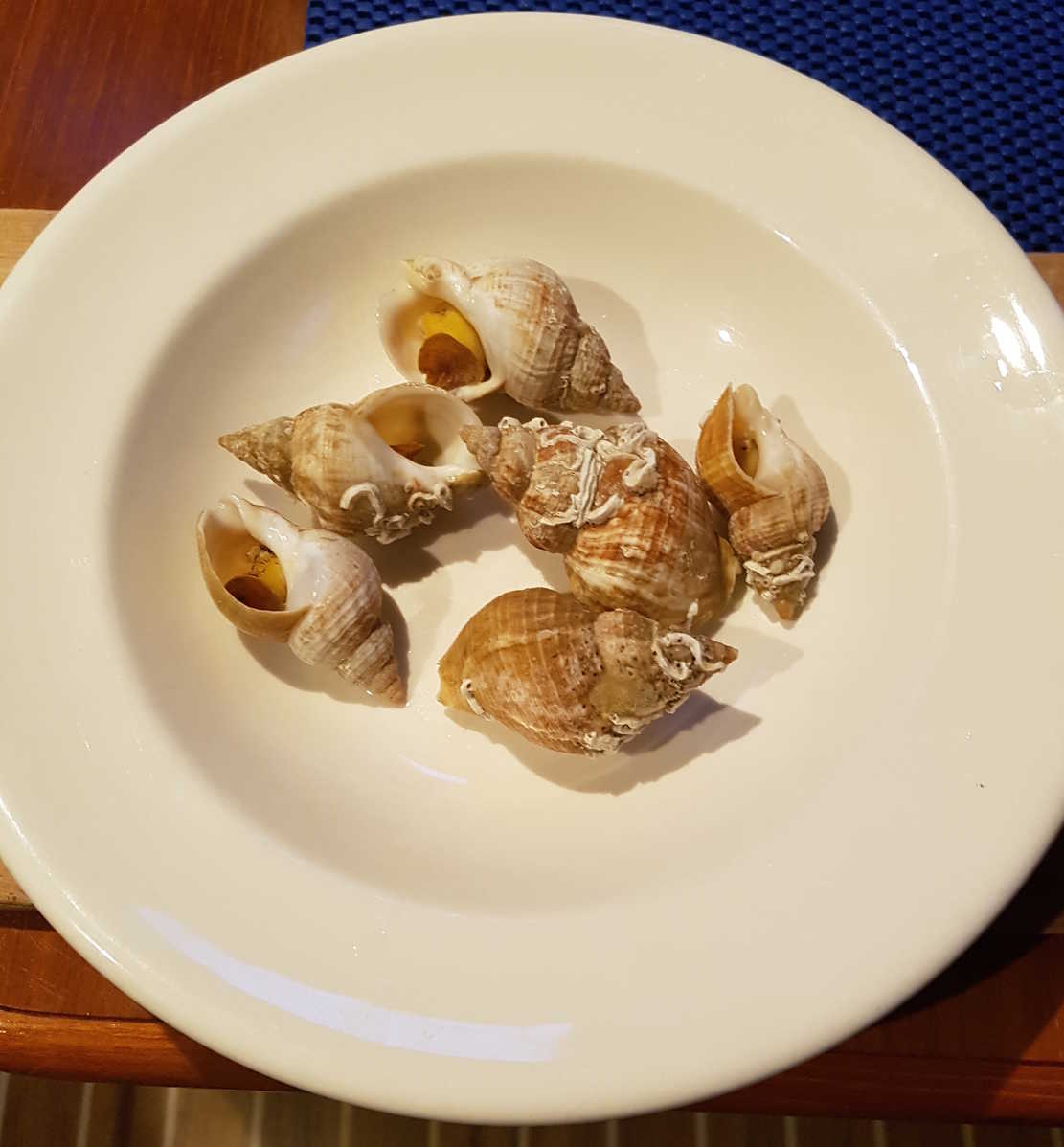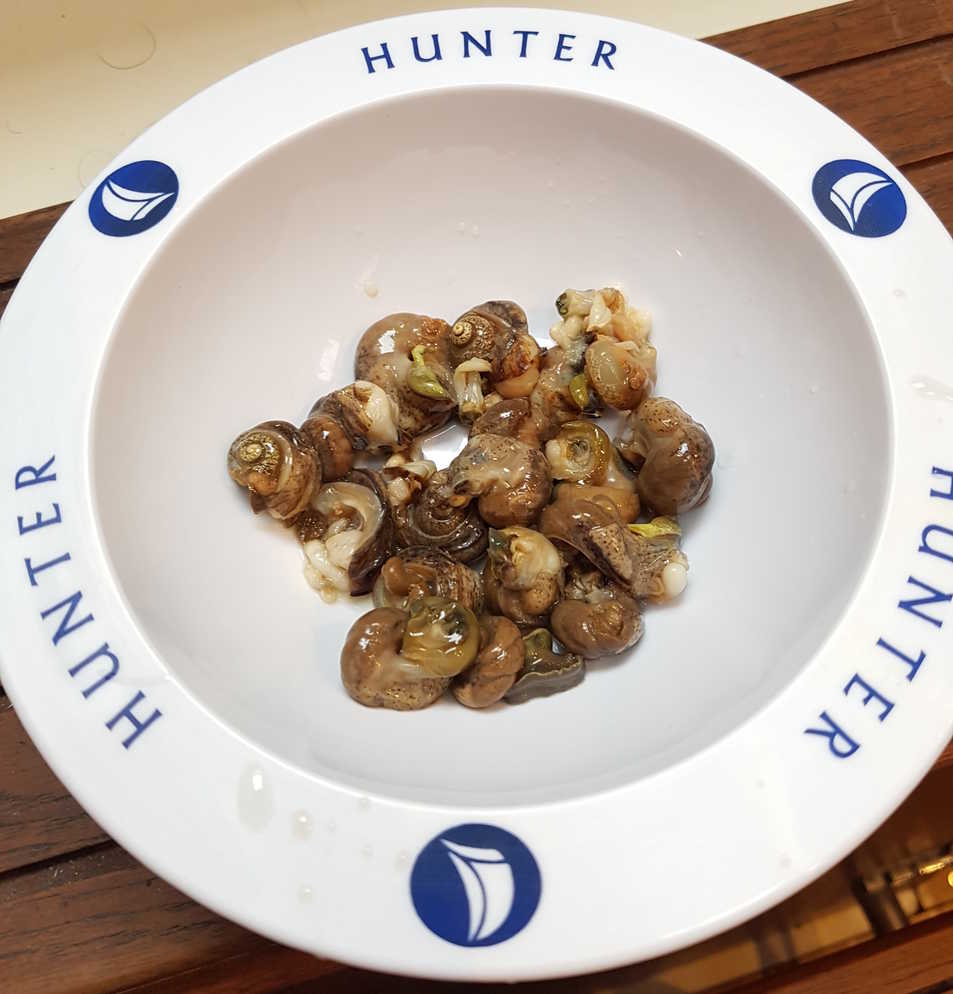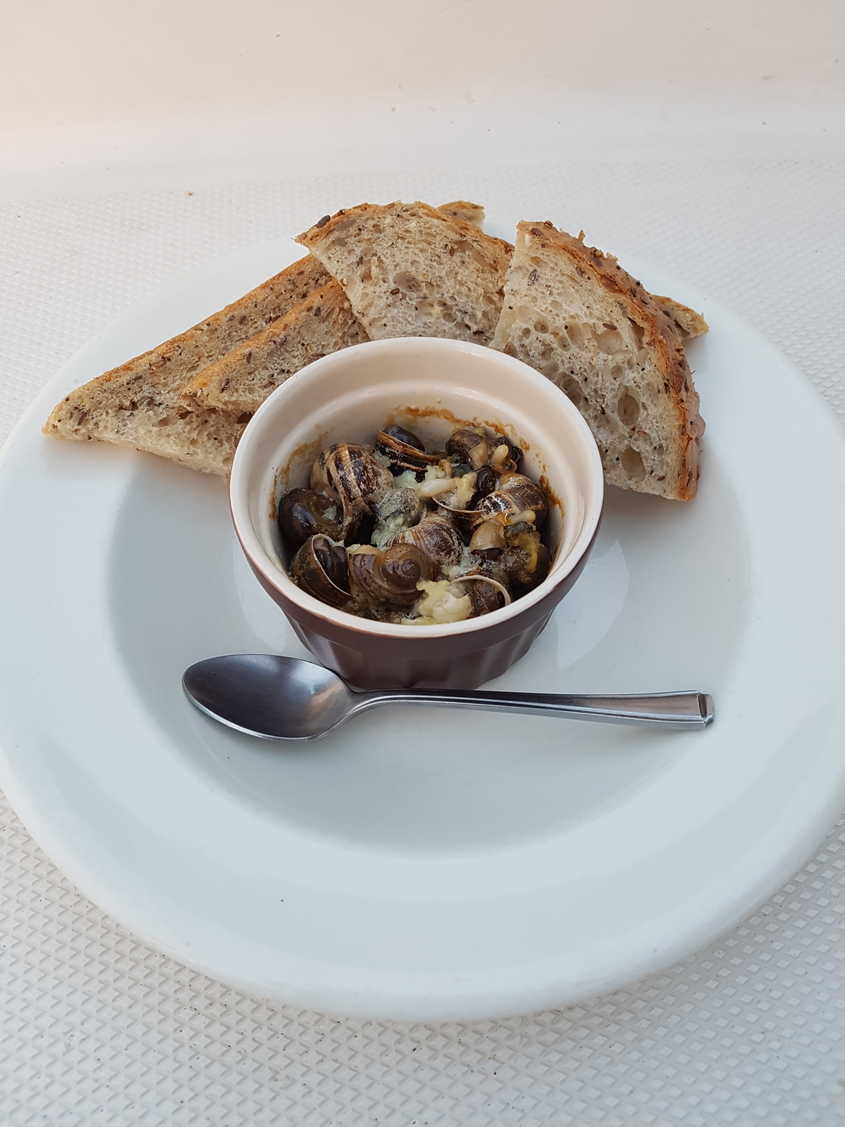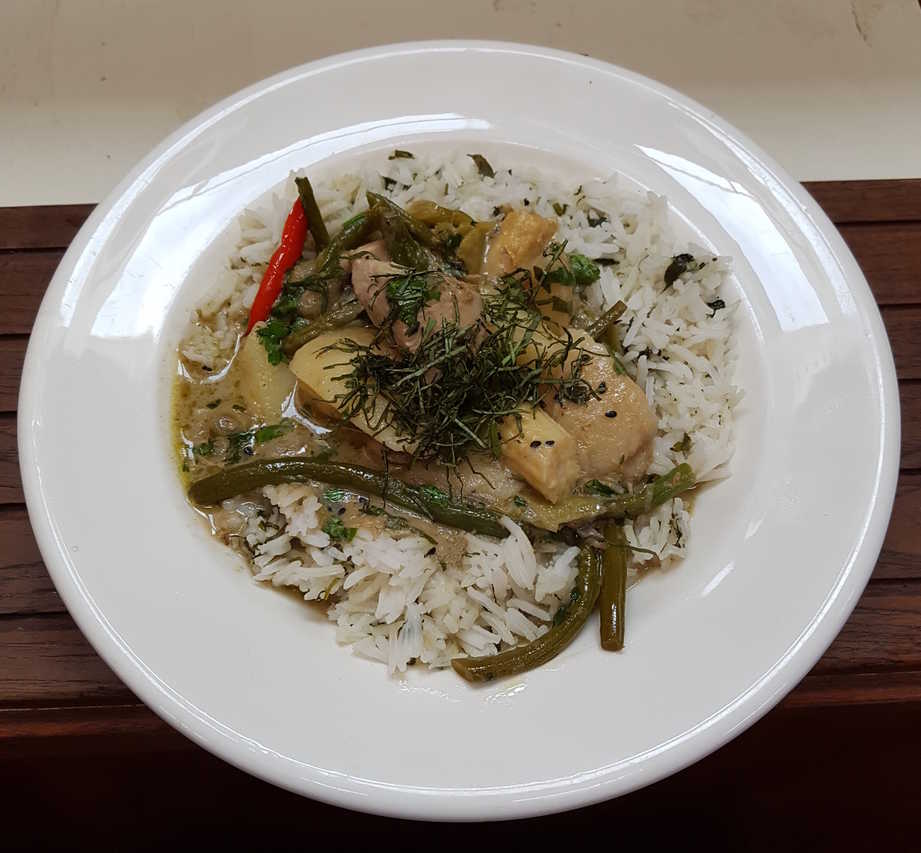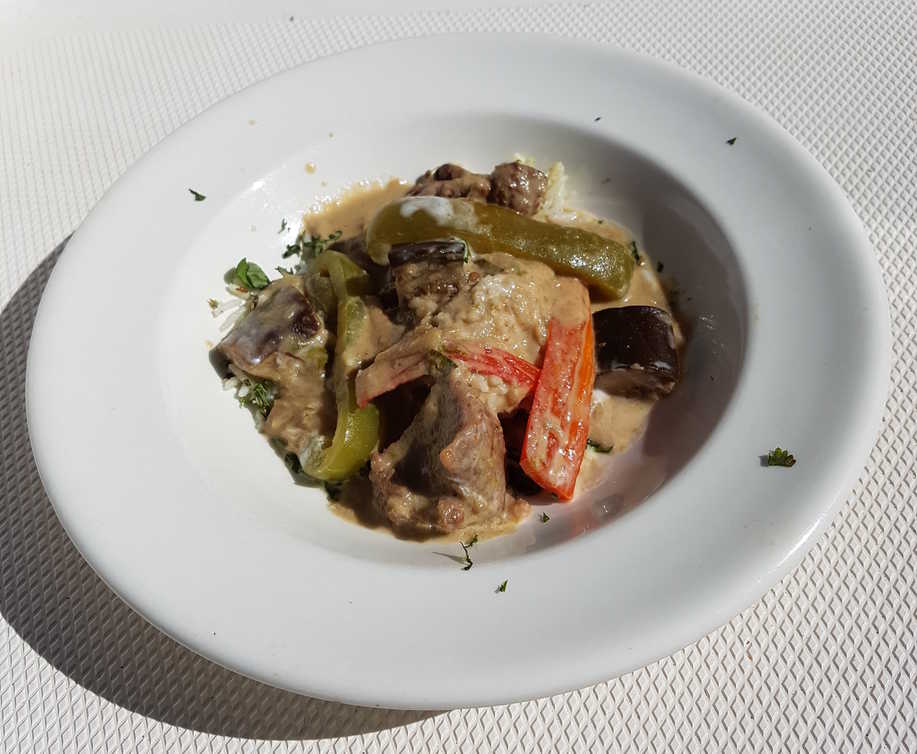There'll Be Bluebirds Over The Brown Cliffs Of Dieppe

Why American bluebirds should be flying over the cliffs of either Dover or Dieppe is anyone's guess - maybe they escaped from a zoo? Anyhoo, they flew us to victory in a World War so who am I to judge?
You can see the coast of France from the shithole that is Dover (it's only about 18 miles away), so I thought I should visit. Well, it would have been rude not to :)
I didn't fancy Calais much, and I wanted to work my way westwards anyway, so I aimed my boat at Boulogne and set sail in a brisk beam breeze.
It wasn't so much that I'd underestimated the Channel tide (which runs at a surprising brisk pace in the middle - reaching over 3 knots at springs) as that I just assumed I would be better able to make up for lost ground when I got closer to France and escaped the strongest tide. So instead of holding my heading for Boulogne I allowed my course to drift eastwards - bearing away for the speed advantage, and ending up on the wrong side of Cap Gris Nez (The Grey Nose) headland with a long beat between me and Boulogne.
My cunning plan of using the bay behind Gris Nez to get out of the adverse tide was defeated by the unexpected (to me) shallowness of the bay, meaning I just had to grit my teeth and sail into the wind for hours, inching my way along the (rather dull) coastline making about half a knot. I finally, and extraordinarily gratefully, arrived at Boulogne's absolutely massive outer harbour in the dark, against a strong wind and heavy sea.
Next time I'll make sure to hold the course I need from the get-go and avoid sacrificing ground for speed.
Funny story, I had always believed the phrase éminence gris meant eminent pig, and so assumed the headland was called (which I thought appropriate)The Pig's Nose.
Until I looked it up.
And then figured out that the former phrase must actually refer to grey men. Live and learn.
The cliffs along the Normandy shoreline around Dieppe (known optimistically as the Alabaster coast) quite closely resemble the more famous cliffs of Dover. Except dirtier-looking. But about as interesting. Fortunately the actual harbour towns are really lovely, authentically historic in a way that British coastal towns are not, having held on fiercely not only to their architecture (they are absolutely littered with chateaux, and nary a cement tower block in sight) but to their traditional markets and small shops.
Between the chateau of Boulogne and the chateau of Dieppe you find the first St Valery, reached by sailing across a very long and tortuous stretch of the Somme, (I doubt we ever fought over it since it spends most of its time underwater. On the other hand - I have seen Blackadder...) and called, not surprisingly, St Valery sur Somme.
The navigable channel is less than obvious and I was relieved to have a yacht to follow in. Though I was less happy when he ran aground in front of me and I had to quickly plan my own course. Turned out he was English anyway, and had no more idea than I did. Or apparently less.
The other side of the chateau of Dieppe (when you can finally escape the first) lies the second Saint Valery - this one en Caux. Quite an old-fashioned harbour town with a thriving local fishing industry (and some fine cheese shops selling fine truffled cheese) where you can find heaps of gleaming whelks for those with more adventurous culinary taste.
For myself, next week I shall be mostly eating this pot of Mae Ploy's Thai green curry paste...
Things I've learned whilst living on a boat:
- There may be a reason your toilet smells awful.
- The reason your toilet may smell.
- You will always discover an item of dirty laundry, immediately you finish doing the laundry.
- Boats do not heal themselves. Except for that compass bubble. That healed itself.
The actual reason my toilet smells awful is an unfortunate side-effect of adding a small device to the inlet pipe which, ironically, is supposed to make the toilet smell better.
It's a pot of a hard disinfectant material which dissolves over time into the inlet water colouring and odourising the inlet water in imitation of those blue tablets you get for real toilets.
Unfortunately, once the disinfectant block has completely dissolved, the container makes an ideal trap for sea-going algae, slime and scum to grow and fester.
Somewhat defeating the purpose.
I have no explanation for the disappearance of my compass bubble.
Whelks
fish starter
Saint Valery-en-Caux on Normandy's Alabaster coast is a medieval fishing port which now does mostly tourism.
However, it does still boast an interesting quay of fish stalls where the six local fishing boats offload and sell their wares direct from the sea.
Yumsk.
I noticed one of the stalls selling mounds of whelks (bulots) which seemed particularly popular with the older locals, so I thought I'd give them a go. The only experience I've had with whelks is eating them pre-cooked and heavily vinegared in English coastal towns where they resemble nothing so much as pickled tumours.
The fisherman managed to convey that I should boil them in water for 10 minutes then eat them with salt and pepper. I soaked mine in a bucket of seawater for a few hours first to let them purge themselves of any grit (easy enough when you live on a boat floating in seawater), then fished them out and gave them a thorough brushing while their little feet were wriggling and extending, to get rid of as much mud and sand as possible.
I'd seen recipes calling for them to be cooked in seawater, but to be honest I've not had much success with cooking things in seawater (though I haven't tried lobster) so I used fresh water, and cooked them for about 8 minutes.
They were delicious! Pity I'd been put off all those years - but they did get a bit boring after a half-dozen. Garlic butter may be required.
You can prise your cooked whelk gently out of its shell with a slight twisting motion using a small knife, fork, pin or cocktail stick, whereupon you'll find various whelky parts:
As you eat them, try not to think of pickled tumours. Or foetuses. Or warts.
Yumsk.
I noticed one of the stalls selling mounds of whelks (bulots) which seemed particularly popular with the older locals, so I thought I'd give them a go. The only experience I've had with whelks is eating them pre-cooked and heavily vinegared in English coastal towns where they resemble nothing so much as pickled tumours.
The fisherman managed to convey that I should boil them in water for 10 minutes then eat them with salt and pepper. I soaked mine in a bucket of seawater for a few hours first to let them purge themselves of any grit (easy enough when you live on a boat floating in seawater), then fished them out and gave them a thorough brushing while their little feet were wriggling and extending, to get rid of as much mud and sand as possible.
I'd seen recipes calling for them to be cooked in seawater, but to be honest I've not had much success with cooking things in seawater (though I haven't tried lobster) so I used fresh water, and cooked them for about 8 minutes.
They were delicious! Pity I'd been put off all those years - but they did get a bit boring after a half-dozen. Garlic butter may be required.
You can prise your cooked whelk gently out of its shell with a slight twisting motion using a small knife, fork, pin or cocktail stick, whereupon you'll find various whelky parts:
- A hard leathery plate called the operculum at the bottom of the foot which seals the shell when the whelk withdraws inside. This part is inedible.
- The solid foot muscle closest to the opening of the shell, white with black speckles, and definitely the tastiest bit.
- A mass of yellow, gelatinous, black-streaked and vaguely translucent guts, gills and organs which resembles the insides of a mussel and surrounds the top of the foot muscle like a hooded cowl. Edible. Probably.
- A darker purple tubular proboscis which connects these latter two and is likely full of grit - this is the whelk's toothed feeding tube which you can pull out and discard
As you eat them, try not to think of pickled tumours. Or foetuses. Or warts.
You'll need 4-6 per person
Ingredients
- whelks
Dressings:- malt vinegar The classic British accompaniment. If you like that kind of thing.
- melted garlic butter
- aïoli
Thoroughly brush off and rinse your whelks - if you can soak them for a few hours (or days) first in seawater (or salted water) all the better.
Simmer the whelks in plenty of water (possibly salted) for 5-10 minutes.
Drain.
Prise the whelk out of its shell, pull free the solid white muscle and discard the leathery foot pad.
Dress.
Eat.
Simmer the whelks in plenty of water (possibly salted) for 5-10 minutes.
Drain.
Prise the whelk out of its shell, pull free the solid white muscle and discard the leathery foot pad.
Dress.
Eat.
Surprisingly pleasant once you've got rid of all the yeuchy bits.
Either that or eat them with your eyes closed.
Snails in Garlic Butter
meat starter
First catch your snails - about a dozen per person, depending on their size. Big fat juicy diners will require more snails.
Or you could have them donated by a kindly Belgian couple in France who were given them in turn by some locals who picked them off the beach - where they were snacking on some tasty seaweed they'd found above the tide-line.
Now they need to be purged since some of the algae and detritus they feast on might not agree with the human digestive system. Rinse them off with fresh water, then feed them on nice food for three days, rinsing them off in-between feeds. Cornmeal, oatmeal, flour or lettuce is good. Herbs might also work - particularly dill, (snails end up tasting of what they've been eating apparently). You should see a lot of poo.
Finally they need to be dried for three days. Hanging them in a net would be ideal - I used a plastic bag with (small) holes punched in it. There should be more poo.
Now they are ready to cook.
Or you could have them donated by a kindly Belgian couple in France who were given them in turn by some locals who picked them off the beach - where they were snacking on some tasty seaweed they'd found above the tide-line.
Now they need to be purged since some of the algae and detritus they feast on might not agree with the human digestive system. Rinse them off with fresh water, then feed them on nice food for three days, rinsing them off in-between feeds. Cornmeal, oatmeal, flour or lettuce is good. Herbs might also work - particularly dill, (snails end up tasting of what they've been eating apparently). You should see a lot of poo.
Finally they need to be dried for three days. Hanging them in a net would be ideal - I used a plastic bag with (small) holes punched in it. There should be more poo.
Now they are ready to cook.
Serve a dozen per person
Ingredients
- snails
- butter
- garlic
- lots of time
Throw your purged, dried snails in boiling water and simmer for 3 minutes. Cool in cold water and drain.
Gently prise the snails bodies out of their shells and wash in heavily salted cold water for 10-15 minutes, then rinse.
Serve with some nice crusty bread and a really tiny fork.
I didn't like the look of the green-tinged and mucousy snails' bellies (feet?) so I cut them away.
This might have been the hepatopancreas (digestive gland)
which I've read is usually removed in larger snails (Gros Gris)
but can be eaten in smaller varieties (Petit Gris).
I chose not to.
The best part is definitely the curly snail meat.
I also heard that after the drying you should cut away any crust which forms around the shell opening. I didn't do this - I don't know if the issues are related.
Meanwhile clean the shells thoroughly (I boiled them in the salted soaking water afterwards).
Mash finely chopped or pressed garlic with good butter.
Press some into a few choice snail shells, then push in a snail body.
If you have one of those fancy restaurant oven dishes with the little snail dimples, now is the time to use it.
Otherwise dot a small ovenproof pot or ramekin with some of the garlic butter, fill with the snails and a few stuffed shells for effect,
then top with the rest of the butter.
I chose not to.
The best part is definitely the curly snail meat.
I also heard that after the drying you should cut away any crust which forms around the shell opening. I didn't do this - I don't know if the issues are related.
I found it too fiddly to bother cooking (and eating) all the snails in their shells, so I just filled a few token ones.
Bake at 200°C/Gas Mark 6 for about 15 minutes until the garlic begins to cook down and take a little colour.Serve with some nice crusty bread and a really tiny fork.
Classic! And ready in under a week.
Thai Green Curry Chicken
main fowl oriental curry thai
Now normally I'd be making my own green curry paste, obviously, but here I am living on a boat.
Actually, that's not the reason. I have a tub of Mae Ploy's ridiculously hot (and rather salty) Green Curry Paste to use up. So Thai Green Curry Chicken is for dinner.
Actually, that's not the reason. I have a tub of Mae Ploy's ridiculously hot (and rather salty) Green Curry Paste to use up. So Thai Green Curry Chicken is for dinner.
Serves 4
Ingredients
- 1-2 stalks lemon grass, chopped, crushed
- 3 cloves garlic, sliced
- coconut or peanut oil
- 1-2 tbsps thai green curry paste
- 500g chicken, cut into chunks or strips
- 1 tin coconut milk
- 1-8 tsps fish sauce
- 1-4 tsps palm sugar
- 1 lime (preferably kaffir), juice and zest (if you like)
Optional Vegetables:- onions (shallots, spring or red), roughly sliced
- mange tout, bias-sliced
- green beans, cut into manageable slices
- baby sweetcorn - sliced lengthways
- birds eye chillies, de-seeded, sliced lengthways
- red (or green) pepper, de-seeded, sliced
- new potatoes, well cooked, chunked
- asparagus, sliced lengthways if thick
- baby aubergines, chopped
- whole kaffir lime leaves
Optional Garnishes:- Thai basil leaves, thinly sliced
- kaffir lime leaves, sliced into chiffonade
- fresh coriander leaves, chopped
Cut a lemongrass stalk or two into pieces then grind them in a pestle and mortar to crush the fibres.
Slice the garlic.
Heat the oil and gently fry the lemongrass and garlic until colouring a little do not burn! then add the green curry paste and fry for a minute or two to release the aroma.
Add the grated lime zest if using, mix in chopped coriander if using, remove from the heat and stir in the lime juice.
Before serving garnish with finely sliced kaffir lime leaves or Thai basil leaves if you like.
Serve with Thai jasmine rice (for best results).
Slice the garlic.
Heat the oil and gently fry the lemongrass and garlic until colouring a little do not burn! then add the green curry paste and fry for a minute or two to release the aroma.
Traditionally the cream of the coconut milk would be cooked until the oil separates, then this used for the frying,
But traditionally you would start with actual coconut milk, not some shitty extract in a can adulterated with stabilizers and guar gum.
Add chicken pieces and stir well to coat, then add the coconut milk.
Bring to a simmer, season with fish sauce and palm sugar then add whatever you vegetables you fancy.
I fancied sliced red onions, chopped green beans, sliced baby sweetcorns, and sliced red chillies.
You can include whole kaffir lime leaves if you like. And, assuming you're not in Dover, you can find some.
Amusingly - I was in the Dover Asda shitstore™ and asked the guy if they sold any herbs.
All I wanted was a little coriander.
He looked at my like I'd inquired as to his procilivity for mating with monkeys. I guess they don't do a lot of herbs in Dover. Not that kind.
Mind you, they do a lot of the other kind. A lot.
Maybe the monkey fucking guy was just stoned?
I actually added some (well) cooked potatoes to my curry (Dover's Asda Shitstore™ does sell potatoes), which seems like heresy to me, but I'd accidentally added way too much green curry paste and made the whole thing far too hot. (In my defence Mae Ploy's Green Curry Paste is ridiculously hot.)
The potatoes did a good job of soaking up some of the extra heat, and worked out not half bad texturally.
Traditionally you might expect to find peppers or chillies, green beans, baby sweetcorn, maybe aubergine. Definitely not potatoes.
Simmer for a few minutes until the vegetables are cooked but retain bite.Maybe the monkey fucking guy was just stoned?
I actually added some (well) cooked potatoes to my curry (Dover's Asda Shitstore™ does sell potatoes), which seems like heresy to me, but I'd accidentally added way too much green curry paste and made the whole thing far too hot. (In my defence Mae Ploy's Green Curry Paste is ridiculously hot.)
The potatoes did a good job of soaking up some of the extra heat, and worked out not half bad texturally.
Traditionally you might expect to find peppers or chillies, green beans, baby sweetcorn, maybe aubergine. Definitely not potatoes.
Add the grated lime zest if using, mix in chopped coriander if using, remove from the heat and stir in the lime juice.
Before serving garnish with finely sliced kaffir lime leaves or Thai basil leaves if you like.
Serve with Thai jasmine rice (for best results).
You can add Thai basil leaves at the end, but don't cook them or they'll turn brown and lose all their flavour.
The curry's flavour will improve if left to rest for 15 minutes or so before serving (freshly garnished).
The curry's flavour will improve if left to rest for 15 minutes or so before serving (freshly garnished).
Thai Green Curry Beef
main meat oriental curry thai
Now you've opened your tub of Mae Ploy's Green Curry Paste
you'll need to be eating a lot of green curries.
Here's another one.
Here's another one.
Serves 4
Ingredients
- peanut oil for frying
- ginger, sliced or galangal
- garlic, sliced
- 2 tbsps green curry paste
- 500g beef chuck/shoulder or bourgignon if you're in Boulogne
- 1 tin coconut milk
- 1-2 tbsps palm sugar
- 1-2 tbsps fish sauce
- aubergine
- shallots, roughly chopped
- green or red pepper
- chilli peppers
- lime zest and juice
- basil Or Thai basil. Or coriander.
Slice or grate the ginger, slice or crush the garlic.
Heat peanut oil and fry until flavour released. Add green curry paste and fry until aroma released (1-2 minutes).
Add palm sugar and fish sauce.
Add the aubergine and simmer for a few minutes to start it softening.
Add peppers, shallots and chillies and simmer until tender.
Add the lime zest, remove from the heat and mix in the juice.
Serve with chopped basil leaves (or coriander).
Heat peanut oil and fry until flavour released. Add green curry paste and fry until aroma released (1-2 minutes).
Feel free to fry a few dried red chillies first if you like their flavour.
Add beef and stir to coat, add coconut milk and bring to a simmer.Add palm sugar and fish sauce.
Add the aubergine and simmer for a few minutes to start it softening.
Add peppers, shallots and chillies and simmer until tender.
Add the lime zest, remove from the heat and mix in the juice.
Serve with chopped basil leaves (or coriander).
To be honest, my bourgignon beef was a bit stringy.
I blame the French (though I did fry it up in the oil before adding the green curry paste - perhaps a mistake).
It wasn't awful but I'd still rather have the chicken
though you'll definitely be bored of Thai green curry chickens if you try and us up a whole pot of
Mae Ploy's Green Curry Paste making them.
Being ridiculously hot, a little goes a long way.
Thai Green Curry Soup
soup oriental curry thai
Or a stew. Depending.
Given the presence of fish sauce and the fact that the green curry paste ought to include shrimp paste, not suitable for vegetarians.
Given the presence of fish sauce and the fact that the green curry paste ought to include shrimp paste, not suitable for vegetarians.
Serves 4-6
Ingredients
- coconut, peanut or other vegetable oil for frying
- 2" ginger, sliced into matchsticks
- 2 lemongrass stalks, chopped, crushed on second thoughts strike these
- 1-2 shallots, minced
- 4 cloves garlic, sliced
- 2-4 tablespoons Thai green curry paste
- 1 sweet potato, peeled, chunked
- 2 tablespoons palm sugar
- vegetable stock
- a splash of rice wine
- 1-2 tablespoons fish sauce
- 1 tin coconut milk
- 1 butternut squash, peeled, de-seeded, chunked
- 1 aubergine, chunked
- dozen shallots, peeled, quartered lengthways
- 1 sweetcorn cob, kernels removed or baby sweetcorns
- dozen unpickled cornichons (i.e. miniature gherkin cucumbers)
- dozen asparagus spears, cut into 2" lengths or green beans
- chestnut mushrooms, cleaned, quartered if large
- any leftover cooked rice you have sitting around
garnish:- bunch coriander, sliced
- grated zest and juice of 1 lime
- bunch Thai basil leaves, sliced
Cut the lemongrass into pieces and crush them with a pestle and mortar.
Slice the ginger into matchsticks.
Mince 2 shallots.
Heat the oil and fry the ginger until starting to colour, followed by the lemongrass until it crisps a little, then add the shallots until they begin to collapse then the garlic. Finally add the green curry paste and fry until the aroma begins to release (1-2 minutes) then add the palm sugar and chunks of sweet potato, stir to coat then add a splash of rice wine and enough vegetable stock to cover, and simmer for 10 minutes to soften the potatoes.
Add the fish sauce and coconut milk, then the chunked butternut squash, bring back to a simmer and add the aubergine chunks, the quartered shallots (held together at their roots), the sweetcorn, cornichons, asparagus spears and mushrooms.
Actually the lemongrass is a bit too stringy in the soup/stew. It works OK in the curry version, but not here - unless you want to grind it up completely.
Slice the garlic thinly.Slice the ginger into matchsticks.
Mince 2 shallots.
Heat the oil and fry the ginger until starting to colour, followed by the lemongrass until it crisps a little, then add the shallots until they begin to collapse then the garlic. Finally add the green curry paste and fry until the aroma begins to release (1-2 minutes) then add the palm sugar and chunks of sweet potato, stir to coat then add a splash of rice wine and enough vegetable stock to cover, and simmer for 10 minutes to soften the potatoes.
Add the fish sauce and coconut milk, then the chunked butternut squash, bring back to a simmer and add the aubergine chunks, the quartered shallots (held together at their roots), the sweetcorn, cornichons, asparagus spears and mushrooms.
You can throw in any leftover cooked rice you have - say from previous cookings of Thai green curries.
The cornichons (tiny cucumbers) added some welcome crunch to the mix.
I saw them in the shop and couldn't resist them, but they don't keep terribly well.
Make sure to scrub them before using too - their bubbly surface collects a lot of dirt.
Pasta with Truffled Gouda
pasta main veg
If you happen to be shopping in one of those tiny but fabulous cheese shops you only seem to find in France
and come across truffled gouda then you should buy some so you can make this dish.
Presumably truffled gouda is also available in Holland. Not that I've seen it, but it's certainly made there though they seem to use exclusively Italian truffles. I'm not sure that truffles grow in Holland.
Unless you're talking about the magic kind. Yep - that's a thing!
Presumably truffled gouda is also available in Holland. Not that I've seen it, but it's certainly made there though they seem to use exclusively Italian truffles. I'm not sure that truffles grow in Holland.
Unless you're talking about the magic kind. Yep - that's a thing!
Serves one
Ingredients
- 4 oz linguine or any other truffle-friendly pasta shape
- olive oil
- 3 cloves garlic, sliced
- 150ml double cream
- 4 oz truffled gouda, cubed or grated from a visit to France, say
- mixed peppercorns, ground
Slightly undercook the pasta, drain retaining half a cup of the cooking water, set aside.
Re-using the same pan, heat a puddle of olive oil and sweat the garlic slices until they begin to brown, without burning. Add the cream, heat, then add the cheese. Loosen the sauce with the reserved pasta water. Return the pasta to the pan and mix well. Serve with a generous grinding of mixed peppercorns.
Re-using the same pan, heat a puddle of olive oil and sweat the garlic slices until they begin to brown, without burning. Add the cream, heat, then add the cheese. Loosen the sauce with the reserved pasta water. Return the pasta to the pan and mix well. Serve with a generous grinding of mixed peppercorns.
Excellent - feel free to bulk the (expensive) truffled gouda with any other melty cheese you might have handy.
Like Beaufort for instance, which I found went well.
I had tried dressing pasta with this truffled gouda before but it really seems to need the cream. And I didn't have any. It wasn't as good.
I had tried dressing pasta with this truffled gouda before but it really seems to need the cream. And I didn't have any. It wasn't as good.
